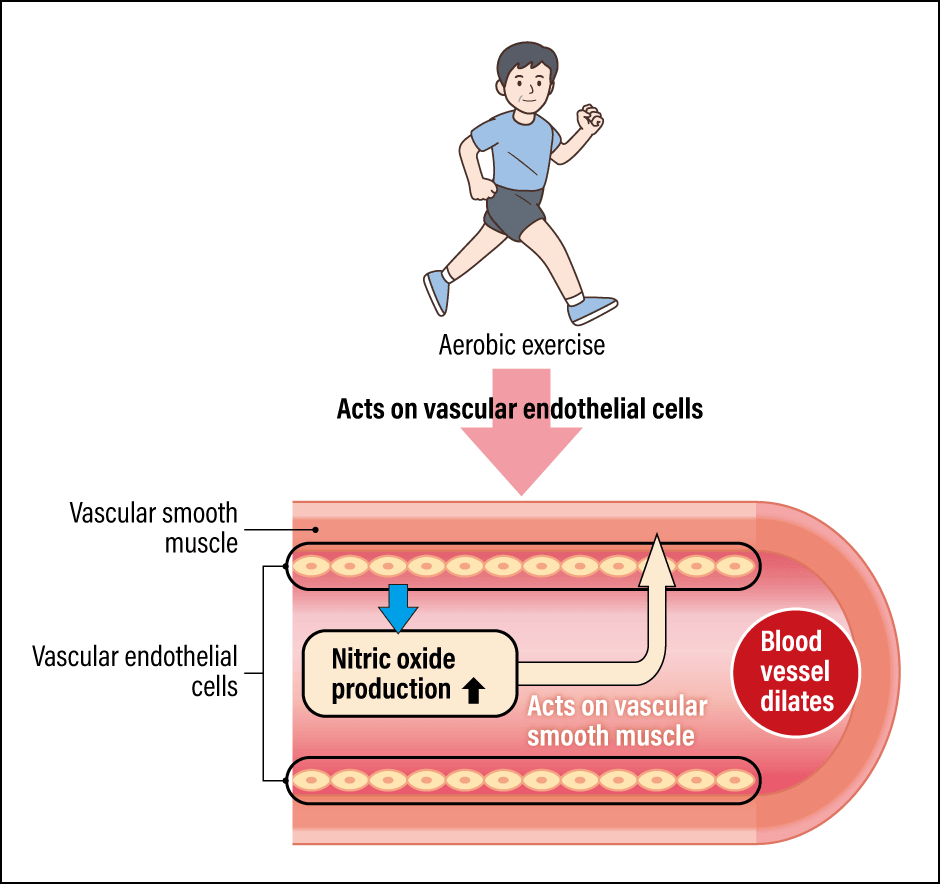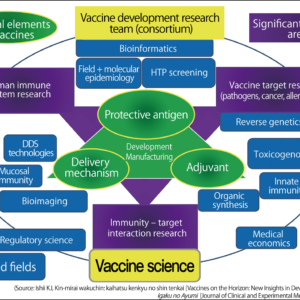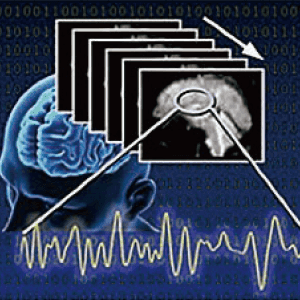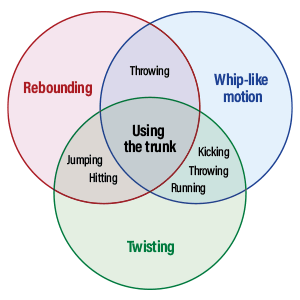Arteriosclerosis is the phenomenon whereby arteries lose their flexibility as we age. While the extent of progression varies from one individual to another, depending on such factors as lifestyle, it is generally possible to delay the progression of arteriosclerosis through appropriate exercise. Moderate to vigorous aerobic exercise over a long period is effective, but as it takes at least two months for the effects to begin emerging, many middle-aged and older people give up before their arteriosclerosis improves and very few continue in the longer term. Accordingly, work is progressing on the development of biomarkers that can predict the effects of exercise. It is hoped that the ability to predict effects will help motivate people to continue exercising.
Special Feature 1 – Sport’s Hidden Depths Biomarkers that predict the effects of exercise on arteriosclerosis
composition by Yumi Ohuchi
illustration by Rokuhisa Chino
I am sure everyone knows that exercise is good for your health. Lack of exercise habit is a factor contributing to lifestyle diseases. One such disease is arteriosclerosis, in which the arteries become thicker and harder, and which is believed to be the root cause of the world’s top two causes of death: ischemic heart disease and stroke (World Health Organization survey, 2020).
While conditions such as obesity and diabetes are regarded as major risk factors for arteriosclerosis, even the arteries of healthy individuals stiffen as we grow older —— humans age along with their blood vessels, as they say. We know that the risks posed by arteriosclerosis increase once people reach middle-age and their older years, in particular. Although the risks for women are low compared with men when young and into middle age, the decline in estrogen resulting from menopause is believed to accelerate arteriosclerosis. The aim of our research is to extend healthy life expectancy by preventing and ameliorating the age-related advance of arteriosclerosis through exercise.
It takes about two months to see an improvement
As a rough guide to the kind of exercise that is effective in preventing arteriosclerosis, the Japan Atherosclerosis Society recommends that people should engage in moderate to vigorous aerobic exercise (activity that feels anywhere from comfortable to somewhat hard) such as walking, jogging, swimming, or step exercises for a total of at least 30 minutes a day, at least three times a week. In an experiment we conducted on middle-aged and older people, we found that moderate to vigorous aerobic exercise for 45 minutes, three times a week lowers pulse wave velocity (hereinafter “arterial stiffness”), which is an indicator of arteriosclerosis.
- * Pulse wave velocity (PWV): A method that involves measuring the velocity of the pulse wave between arteries in two locations, principally by means of blood pressure pulse wave examinations. It is used as a standard universal indicator; a faster velocity of blood flow through blood vessels (PWV) between the two points indicates that arteriosclerosis is more advanced. Carotid-femoral PWV (cfPWV) or brachial-ankle PWV (baPWV) may be used.
On the other hand, we also found that the reduction in arterial stiffness is gradual, and that it takes about two months for an improvement to emerge. We regard this as a barrier to preventing arteriosclerosis by means of exercise. When people who are not originally in the habit of exercise take it up, they often find it hard to keep going, as I am sure some of you will have experienced for yourselves. In a study examining the rate of continued use of a gym by 5,240 people in Brazil, 53.5% managed to continue going for two months after joining, but this figure dropped to 13.6% after six months, and just 3.7% were still going after a year. In other words, we can surmise that about half of people give up regular exercise before their arteriosclerosis improves. Accordingly, we believe it is necessary to identify biomarkers that can predict the effects of exercise at an early stage. Various phenomena occur in the body before arteriosclerosis improves as a result of exercise, such as increases or decreases in specific genes or proteins. Those specific substances can serve as biomarkers.
If we can predict the effects of exercise using biomarkers, we can expect to see increased motivation to exercise, which will prevent people from dropping out (Figure 1). Moreover, as the effects of exercise differ according to such factors as cardiopulmonary function and muscle mass, it will be possible to create personalized exercise programs for each individual based on a regular assessment of their biomarkers.

Figure 1. Biomarkers that can predict the effects of exerciseIt takes about two months for an improvement in arteriosclerosis to emerge, and the inability to continue exercising is a barrier to preventing arteriosclerosis. If biomarkers can be used to predict the effects of exercise at an early stage, we can expect people’s motivation to exercise to increase.
While the mechanism via which aerobic exercise improves arteriosclerosis has not yet been fully unraveled, numerous studies to date have reported that aerobic exercise encourages the vascular endothelial cells that form the innermost lining of blood vessels to produce nitric oxide (NO), which acts on vascular smooth muscle, causing blood vessels to dilate and thereby reducing arterial stiffness (Figure 2).

Figure 2. Mechanism via which aerobic exercise improves arteriosclerosisSome aspects of the exact mechanism are yet to be clarified, but the key point is that aerobic exercise has the effect of promoting the production of nitric oxide for the vascular endothelial cells.
One substance that has been the focus of research as a potential biomarker is a bioactive substance (hormone) called adropin. Adropin is expressed in numerous tissues, including brown adipose tissue, white adipose tissue, the liver, the aorta, the small intestine, the heart, the kidneys, skeletal muscle, the brain, the lungs, and the spleen. Involved in the metabolism of lipids and glucose, adropin levels are said to decline as we age. We know that in blood vessels, adropin is expressed in endothelial cells and smooth muscle, causing them to produce NO. In an experiment using a special microscope that shows the hardness of blood vessels, we proved that adding adropin to vascular endothelial cells in the human aorta reduces the hardness of vascular endothelial cells via increased NO production.
In an experiment using senescence-accelerated mice, we found that aerobic exercise caused increased expression of the adropin gene in the aorta, resulting in greater production of adropin in the blood and NO in the arteries, along with improved vasodilation functions. These results showed us that a rise in adropin is involved in the molecular mechanism that helps to improve the age-related decline in vascular endothelial function. Additionally, we have obtained results from tests on adropin gene knockout mice that showed their arteries to be harder than those of ordinary mice.
Hormones are secreted in response to muscle activity
We also conduct clinical research on humans, including healthy middle-aged and older people, and people with obesity. In these studies, we found that aerobic exercise caused an increase both in the level of adropin in the blood and in NO production, while arterial stiffness decreased. Thus, both basic and clinical research show that adropin is involved in the improvement of arteriosclerosis through aerobic exercise.
We are currently also focusing on a type of myokine called apelin as a biomarker. Myokines are hormones secreted by skeletal muscles. More than 20 types of myokine have been discovered as a result of advances in research over the last 20 years. Scientists have said that substances secreted by a particular tissue are involved in the functions of that specific tissue, such as the way in which substances secreted by the blood vessels act on the blood vessels. However, we know that myokines are secreted by skeletal muscle and act on various other organs throughout the body via the blood, including the brain, blood vessels, intestines, liver, kidneys, and pancreas.
In other words, while there are indirect reasons why exercise is good for us, such as the fact that it burns fat, thereby causing us to lose weight, scientists are starting to think that exercise is also beneficial because the stimulus it provides activates the muscles and causes the myokines secreted as a result to exert a positive effect on the whole body. Although levels of the myokine apelin are high when we are young and decline as we age, we know that aerobic exercise causes apelin levels in the blood to increase, suggesting that it could potentially be involved in improving arteriosclerosis.
In fact, our previous animal research and studies on middle-aged and older people have also shown that, just like adropin, apelin is involved in the production of NO due to aerobic exercise and the improvement of arteriosclerosis. However, nobody had considered when the increase in adropin and apelin resulting from habitual aerobic exercise begins and whether they were involved in ameliorating arteriosclerosis.
Accordingly, we conducted a study of healthy middle-aged and older people (with an average age of 66), randomly assigning 17 of them into a group doing exercise and 16 into a group not doing exercise (the control group). We then conducted a study examining changes in the blood concentration of adropin, apelin, and NO. The balance of men to women was 7:10 in the exercise group and 6:10 in the control group, with at least five years having elapsed since menopause in the case of the women. In other words, the subjects were all people thought to be at higher risk of arteriosclerosis. Both groups went about their normal lives, except for in relation to whether or not they did exercise, and we confirmed via questionnaires and surveys to measure activity conducted before and after the study that there had been no change in this regard.
The exercise group performed medium to vigorous aerobic exercise using a bicycle ergometer (stationary cycling) for 45 minutes a day, three days a week, for eight weeks. Blood concentrations of adropin and apelin in the exercise group gradually rose, with a statistically significant increase in both levels compared with the starting point of the exercise observed in the fourth week. Subsequently, NO concentrations increased in the sixth week, while arterial stiffness decreased (Figure 3). The fact that the increase in NO coincided with the decline in arterial stiffness is thought to be associated with the fact that NO is metabolized very quickly.

Figure 3. Apelin’s potential as a biomarkerIn a study of healthy middle-aged and older people, apelin was found to increase in the fourth week after starting the exercise program, indicating its potential as a biomarker.
When we investigated the respective correlations of adropin and apelin to NO, we found that apelin in particular was associated with changes in NO, which led us to believe that it is a useful biomarker. There have been reports from studies that have measured apelin levels in saliva; if it became possible to measure apelin levels from a drop of blood, using something like the blood glucose monitors used by diabetics, or even saliva, anyone could easily check the effects of exercise.
However, before apelin can be put to practical use as a biomarker, we first need to shed light on the mechanism via which apelin brings about improvements in arteriosclerosis. As basic research is also crucial to this goal, we are currently planning experiments on mice from which the apelin gene has been removed and experiments to consider the effects of apelin in human vascular endothelial cells.
At present, apelin is presumed to be more useful as a biomarker than adropin, but given that different results could conceivably emerge from studies involving a larger number of subjects, further research is required. Depending on the results, we might even find that, rather than being either adropin or apelin, the biomarker is a combination of the two.
Nor can we reject the possibility of there being a substance whose levels change due to exercise even sooner than adropin or apelin. The ideal biomarker is a substance in which fluctuations can be perceived at as early a stage as possible. Efforts to discover such a substance will probably need to be carried out in parallel with the current studies of adropin and apelin.
Sustaining a type of exercise you like is easier
So far, I have primarily discussed the effects of aerobic exercise, but I believe it is also important to consider the effects of resistance training to build muscle strength. Resistance training is regarded as an effective form of exercise for increasing muscle mass and strength, which decline as we age. However, many aspects of the mechanism involved in its relationship to arteriosclerosis are unclear, unlike in the case of aerobic exercise, and it is only in recent years that studies of the effects of resistance training on the blood vessels have begun.
For example, while there are reports that age-related deterioration of blood vessels is further exacerbated in elderly people who undertake routine high-intensity resistance training, studies in which elderly people undertook medium-intensity resistance training reported no effects on arterial stiffness. It remains unclear whether resistance training is effective in curbing arteriosclerosis, but it would appear that the effects differ according to the level of intensity of the exercise and that high-intensity resistance training has no desirable effects. Furthermore, as high-intensity resistance training places a substantial burden on the body in middle-aged and older people, we are first undertaking studies that consider the effects of low-intensity resistance training.
There are also reports that stretching exercises can reduce arterial stiffness. For example, the results of studies of middle-aged men and middle-aged and older women have shown four weeks of stretching exercises to be effective. Other studies have reported results suggesting that stretching exercises should be carried out in the long term, but either way, it is clear that habitual stretching reduces arterial stiffness.
Some people, myself included, prefer resistance training over aerobic exercise. Engaging in a form of exercise that you enjoy is likely to make it easier to keep it up. In the case of people who find aerobic exercise and resistance training difficult, such as those with reduced physical strength or disabilities, stretching exercises are likely to be more appropriate. We do not yet know whether appropriate biomarkers differ from one mode of exercise to another. In the case of myokines, there have been reports that, in addition to hormones like apelin that increase due to aerobic exercise, there are also hormones whose levels rise as a result of resistance training.
Whatever the form of exercise concerned, it is necessary to shed light on the mechanisms behind the effects of exercise in ameliorating arteriosclerosis and to identify biomarkers, in order to extend healthy life expectancy. Accordingly, I plan to continue undertaking research across the spectrum, from basic to clinical, in order to investigate the relationship between exercise and arteriosclerosis.




















